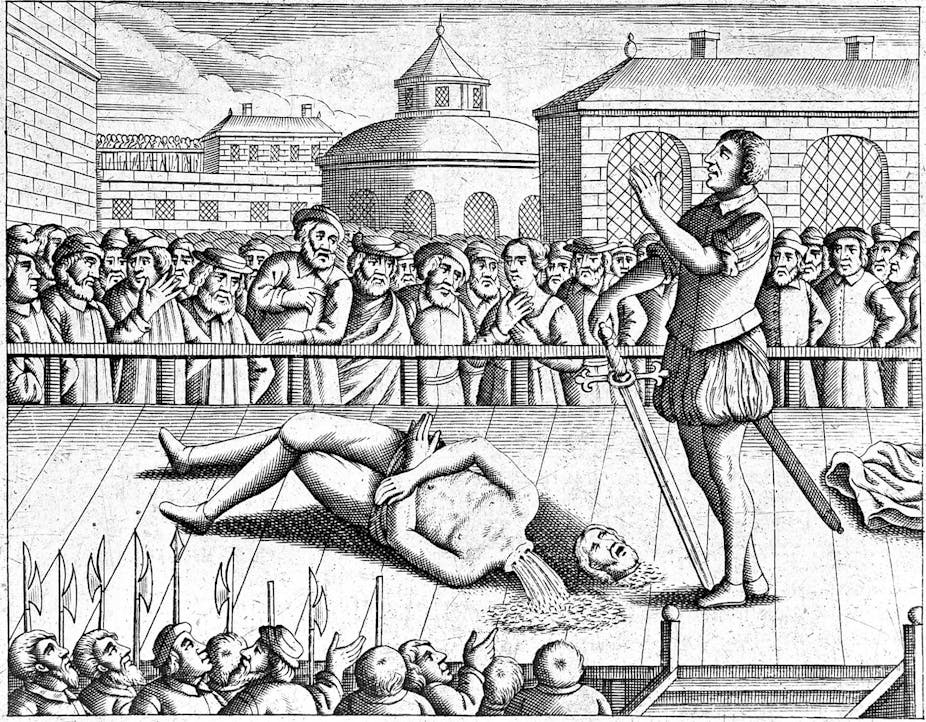Whether it’s the recent mass death sentences handed down by the Egyptian judiciary after the ill-fated Arab Spring uprising, or US states having to delay executions of Death Row prisoners because European drug companies are refusing to supply them with the drugs required, capital punishment regularly dominates the news headlines.
Central to all of these stories is the publicity they receive. If you’re going to practice capital punishment as a deterrent – a claim still made despite statistics having shown that the death penalty has no effect on crime rates – then there’s no point doing it unless as many people as possible can find out about it. Now such information zips around the world on the internet. But how did people find out about crime and punishment in that era of spectacular public executions, the Renaissance?
In the early modern period, the majority of the European population was illiterate, and so more creative ways of broadcasting the horror were needed. So news stories were regularly printed in song form, and sung publicly in streets, markets and fairs.
The dance of death
Ballads were often set to well-known tunes, increasing the likelihood of pricked ears and allowing anyone to instantly sing along. Rhythm, melody, and rhyme allowed songs to be more easily memorised than a prose version of events and therefore more likely to be shared. Like news reporting today, crime and punishment fascinated audiences, and so execution ballads were the most popular sub-genre of news songs, offering details of the crimes and the often brutal and gory punishment of the criminal.
Take, for example, the ballad about the unfortunate Edward Coleman, a courtier under Charles II, who was executed for treason, having been implicated in a fabricated “Popish Plot” to murder the king. Set to the popular tune “Packington’s Pound”, one of its verses goes:
To the place of Destruction tencounter grim death,
And there by a Cord to resign half his breath:
His Bowels ripd out, in the flames to be cast,
His Members disseverd on Poles to be placd:
A sight full of horror, but yet its most just
That they shoud first bleed, that after blood thirst.
One might well ask why people would want to sing the graphic details of a person being hanged, chopped into pieces and burned. But the communal participation in the songs echoed the participation by spectators in the process of execution itself; the entire community was expected to be involved. Not only would crowds gather at the gallows, but spectators would gather all along the journey from the prison to the execution site to jeer at, pray for, and sing with the condemned.
Execution ballads are therefore almost universally conservative, preaching a highly moralising message of repentance. The condemned is always portrayed as guilty and their crimes are described in detail, often beginning with what one might call “gateway sins” – not going to church or gambling – which inevitably lead to more serious crimes like murder and treason. They go to their deaths wholly remorseful, begging God for mercy and, most importantly, warning spectators and listeners to learn from their mistakes and repent before it’s too late.
Ventriloquism
This was done most powerfully through a conceit that many ballads use, which is to put the song in the first person voice of the condemned criminal. For a moment at least, the singer of the execution ballad could vicariously experience the emotions of a person in their last moments of life, and feel the fear and remorse that a victim of execution might feel. Judith Brown, a maidservant burned to death in 1684 for the murder of her mistress, sings at the end of her ballad:
In this devouring flame,
My life must now expire,
Alas my sins I needs must blame
I end my days in fire.
But the condemned didn’t always come off so well. Catholic heretic John Felton isn’t treated nearly so sympathetically in his 1570 ballad. This was set to a country dance tune, and ridiculed the quartering and display of his severed limbs on the gates of London:
His quarters stand not all together
But ye mai hap to ring them thether
In place where you wold have them be
Then might you doe as pleaseth ye.
For whye? they hang,
Unshryned each one upon a stang:
Thus standes, the case,
On London gates they have a place.
His head upon a pole
Stands wavering in ye wherling wynd
So songs about executed criminals could be plaintive, vengeful, or even mocking, but they always reminded their listeners and singers that sin would be violently punished. The spectacle of the scaffold was meant to instil fear into the hearts of the crowd, and compassion for the repentant criminal, who could act as a voice from the no man’s land between life and death to warn of the dangers of sin and crime.
With their ability to be easily sung, memorised, and passed on, ballads were a perfect medium in the early modern period for telling the stories of those unfortunate souls who felt the wrath of the authorities. But remember, such things are far from consigned to history. Given the recent job advertisement by the Saudi Arabian government for eight new executioners, these are stories that will continue to be told.

